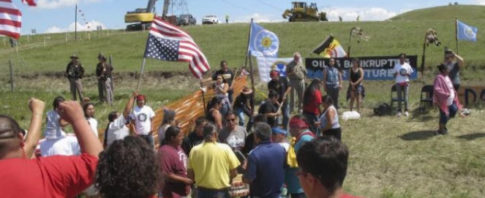Submitted by Zainab Calcuttawala via OilPrice.com,
The fight over the fate of the 1,168-mile Dakota Access pipeline (DAPL) intensified on Saturday, when a clash between private security agents defending the construction site and Native American protestors led to several injuries for both parties.

A crew from Democracy Now! posted a video of the incident on YouTube, which showed the mouth of one of the several guard dogs, reportedly managed by private security personnel, covered with the blood of a protestor.
A total of six people – including a young child – were bitten by dogs, according to Steve Sitting Bear, a spokesperson from the Standing Rock Sioux Reservation, who also said the private guards pepper-sprayed at least 30 protestors.x
Four private security agents and two guard dogs also suffered injuries, according to the Morton County sheriff’s office spokesperson Donnell Preskey. One member of the private security team sought medical attention at the Bismarck hospital due to undisclosed injuries, the Associated Press reported.
In what has become the largest gathering of Native Americans in more than 100 years, a coalition of dozens of tribes across the country oppose the pipeline’s construction, citing concerns that it would put the Missouri River – as well as the network of lakes and tributaries that the “Big Muddy” is connected to – at risk of contamination via oil spill and lead to the destruction of culturally significant sites for the Sioux tribes in the area.
“This is the first time the seven bands of the Sioux have come together since [the Battle of] Little Bighorn [in 1876],” Hawste Wakiyan Wicasa, a Native American man living in a tent at protest camp in the Standing Rock Sioux Reservation, told the BBC.
“Now, we have no weapons, only prayers. We are here for what our ancestors fought and died for. We have endured 250 years of betrayal by the white man.”
Saturday’s clash began when a group of several hundred protestors gathered near construction crews on Saturday afternoon at a site close to the Standing Rock Sioux Reservation. The demonstrators aimed to act as a human shield against the pipeline’s further development, after the removal of topsoil from a 150-feet wide and 2-mile long portion of land caused “devastating” damage to the tribe’s sacred lands.
“Once protestors arrived at the construction area, they broke down a wire fence by stepping and jumping on it,” the local sheriff’s narrative reads, though no law enforcement officers were present at the site. “According to numerous witnesses within five minutes the crowd of protestors, estimated to be a few hundred people became violent. They stampeded into the construction area with horses, dogs and vehicles.”
Videos of Native Americans and allied environmentalists demonstrating against the $3.8 billion pipeline in August show them chanting and marching, with police officers present at the scene.
Refiner Phillips 66 currently owns a 25 percent stake in the DAPL and another associated pipeline called Energy Transfer Crude Oil (ETCO). Energy Transfer Partners (ETP) and its partner, Sunoco Logistics, agreed to sell 36.75 percent of their 75 percent joint stake in both pipelines to a company co-owned by Marathon Petroleum and Enbridge Energy Partners for $2 billion in early August – days after the Army Corps of Engineers granted the permits necessary to build the line just under the Missouri River, near the Native American Reservation.
That deal is expected to close sometime in Q3.
The future of the pipeline, which runs through North Dakota, South Dakota, Iowa and Illinois, will be determined by Friday, after a Tuesday hearing in Washington D.C. regarding a temporary injunction on future construction on the 2-mile stretch of topsoil-barren land near Lake Oahe.
The Corps recently announced that it would not oppose the tribe’s temporary work stoppage request in order to prevent further clashes and keep the peace near Lake Oahe.
The Standing Rock tribe filed the injunction as part of a larger lawsuit against the Corps for authorizing the pipeline’s construction permits in violation of the Clean Water Act, National Historic Preservation Act and the National Environmental Policy Act.
If constructed, the underground pipeline would transport 470,000 barrels of oil from the Bakken oil formation in North Dakota, which, the U.S. Geological Survey estimates holds 7.4 billion barrels of undiscovered oil. ETP – the largest American pipeline company by volume of goods transported – says the line will be an environmentally-friendly way to transport crude to refineries in the Midwest, East Coast and Gulf Coast. Without the line, oil producers would be forced to use rail lines or trucks to move their products – which would lead to further air pollution.
“Monitored 24 hours a day, seven days a week and 365 days a year, including rigorous pipeline integrity planning and maintenance, federal statistics show that underground pipelines transport crude oil more safely than ships, rail, or trucks,” the company’s site says.
The new line would also help the U.S. become less dependent on energy from unstable countries and create up to 12,000 new construction jobs domestically, according to figures cited by CNN. State and local governments would earn roughly $156 million in sales and income taxes and the company will pay roughly $1 billion to the American companies providing parts for the pipeline.
With environmental arguments on both sides, would North Dakota’s nature and wildlife be better off with or without the pipeline? And if building the pipeline would be better for the environment, will the protection of Native American sacred sites be a strong enough reason for U.S. courts to revoke the pipeline’s construction permits?
* * *
PayPal: Donate in USD
PayPal: Donate in EUR
PayPal: Donate in GBP
I love dogs, but if I was bit by one I would have to break it’s neck! The moment they let the dog bite anyone the men should have attacked and killed all the dogs!!!!!!!